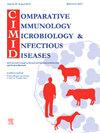Staphylococcus spp. and methicillin-resistance gene mecA dispersion in seawater: A case study of Guanabara Bay's recreational and touristic waters
IF 2
3区 农林科学
Q4 IMMUNOLOGY
Comparative Immunology Microbiology and Infectious Diseases
Pub Date : 2025-02-12
DOI:10.1016/j.cimid.2025.102326
引用次数: 0
Abstract
Environmental Staphylococci, particularly coagulase-negative Staphylococci (CoNS), are known reservoirs of antimicrobial resistance genes and human-animal opportunistic pathogens, yet their role within the One Health framework remains underexplored. In this study, we isolated 12 species of CoNS from two sites 10 km apart in Guanabara Bay, Rio de Janeiro, with the most frequent species being the opportunistic Staphylococcus saprophyticus (30.3 %), Staphylococcus warneri (25.7 %), and Staphylococcus epidermidis (16.7 %). GTG5-PCR fingerprinting revealed significant genetic diversity, yet identical profiles persisted across both sites throughout the year, indicating strain dispersion and persistence. Among the 66 strains analyzed, 42 exhibited resistance to clinically significant antimicrobials, including methicillin-resistant strains harboring the mecA gene. Remarkably, 22.7 % of the strains carried CRISPR-Cas systems, a frequency unusually high for Staphylococcus spp., suggesting that bacteriophage pressure in the seawater environment may drive this increase. The presence of antimicrobial-resistant CoNS in Guanabara Bay, a popular recreational area, represents a potential public health risk.
葡萄球菌和耐甲氧西林基因在海水中的扩散:瓜纳巴拉湾休闲和旅游水域的个案研究
环境葡萄球菌,特别是凝固酶阴性葡萄球菌(con),是已知的抗菌素耐药基因和人-动物机会性病原体的储存库,但它们在“同一个健康”框架中的作用仍未得到充分探讨。本研究从巴西巴西瓜纳巴拉湾两个相距10 km的地点分离到12种金黄色葡萄球菌,其中最常见的是机会性腐生葡萄球菌(30.3% %)、warneri葡萄球菌(25.7% %)和表皮葡萄球菌(16.7% %)。GTG5-PCR指纹图谱显示了显著的遗传多样性,但相同的谱在两个地点全年都存在,表明菌株分散和持久性。在分析的66株菌株中,42株表现出对临床重要抗菌素的耐药性,包括含有mecA基因的耐甲氧西林菌株。值得注意的是,22.7% %的菌株携带CRISPR-Cas系统,这一频率对于葡萄球菌来说异常高,这表明海水环境中的噬菌体压力可能推动了这种增加。瓜纳巴拉湾是一个受欢迎的休闲区,在那里存在抗微生物的con,构成了潜在的公共健康风险。
本文章由计算机程序翻译,如有差异,请以英文原文为准。
求助全文
约1分钟内获得全文
求助全文
来源期刊
CiteScore
4.60
自引率
0.00%
发文量
102
审稿时长
40 days
期刊介绍:
Comparative Immunology, Microbiology & Infectious Diseases aims to respond to the concept of "One Medicine" and to provide a venue for scientific exchange. Based on the concept of "Comparative Medicine" interdisciplinary cooperation between specialists in human and animal medicine is of mutual interest and benefit. Therefore, there is need to combine the respective interest of physicians, veterinarians and other health professionals for comparative studies relevant to either human or animal medicine .
The journal is open to subjects of common interest related to the immunology, immunopathology, microbiology, parasitology and epidemiology of human and animal infectious diseases, especially zoonotic infections, and animal models of human infectious diseases. The role of environmental factors in disease emergence is emphasized. CIMID is mainly focusing on applied veterinary and human medicine rather than on fundamental experimental research.

 求助内容:
求助内容: 应助结果提醒方式:
应助结果提醒方式:


